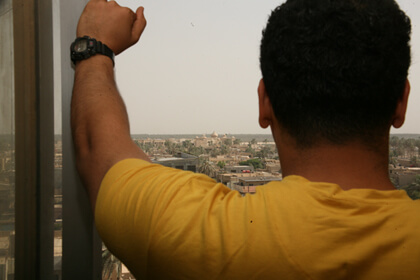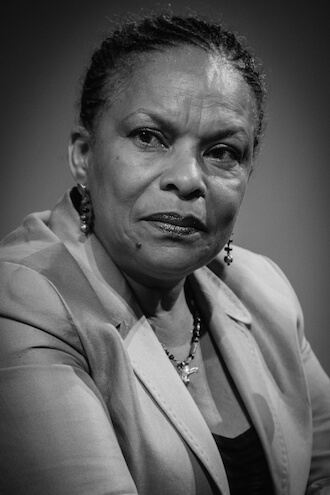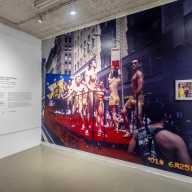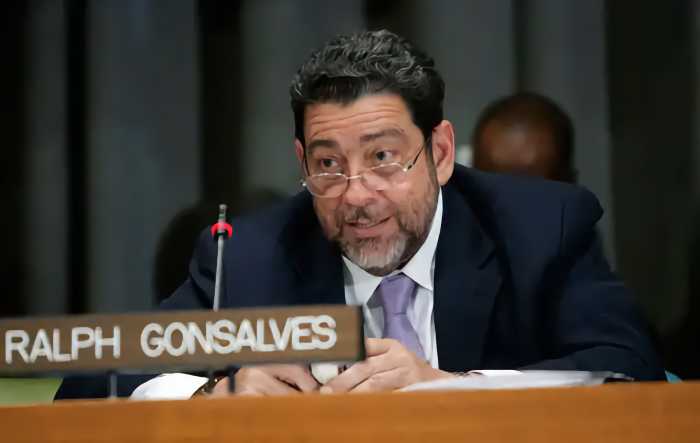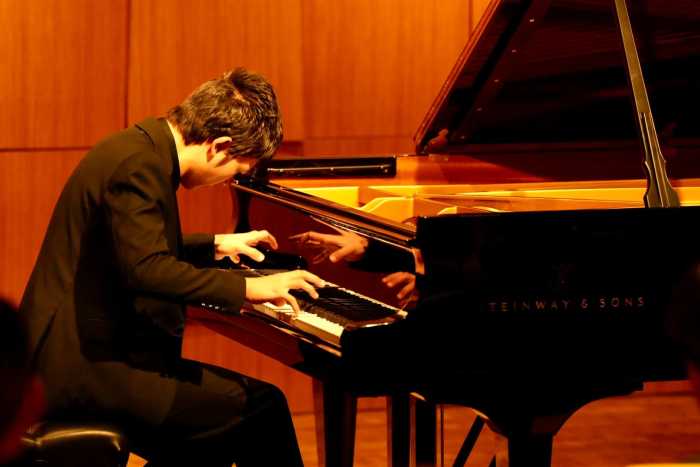Two men holding hands in 2009 in Baghdad’s Karada district, where gays at times have felt comfortable being visible. | MICHAEL LUONGO
The US invasion of Iraq in 2003 unleashed a wave of sectarian religious violence in what was once a relatively secular country, where conflict was held in check by brutal dictator Saddam Hussein. Along with women, religious minorities, artists and other creative people, and other groups, LGBT Iraqis faced brutal persecution from militias that sprang up in the wake of the American occupation.
Now, in addition to internal issues unresolved nearly 12 long years later, a new threat exists for LGBT Iraqis from ISIS, the Islamic State, which has wreaked havoc in Iraq and neighboring Syria, leading to a massive refugee crisis and further destabilization of the region.
Gay City News has covered the crisis facing gays in Iraq from the beginning of the war, with both direct reporting from Baghdad and other locations there as well as remote reporting using sources inside the country. This reporter traveled to Iraq twice –– in 2007 and 2009 –– and met with a wide variety of LGBT people there.
IGHLRC, women’s rights groups draw on personal stories to emphasize continuing threat, new risks from ISIS
Violence against LGBT Iraqis has risen and fallen in the years since the invasion, perhaps peaking in 2007, at the time of the US military surge.
But in a pair of new reports, the International Gay and Lesbian Human Rights Commission, a group that has United Nations observer status, makes clear that the peril facing LGBT Iraqis has not gone away and, in fact, saw a lethal resurgence over the past year.
The IGLHRC reports, produced in conjunction with MADRE, an international women’s human rights organization, and the Organization of Women’s Freedom in Iraq (OWFI), which is based in Baghdad, are titled “When Coming Out is a Death Sentence” and “We’re Here: Iraqi LGBT People’s Accounts of Violence and Rights Abuses.” The second report is alternatively titled “The Iraqi LGBT Memoir Project” and is based on interviews with a group of five LGBT Iraqis –– three gay men, a lesbian, and a transgender woman. The stories that comprise “The Memoir Project” are personal and harrowing, detailing not just anti-gay violence but how the general chaos of a war-zone exacerbates the issue.
Under the pseudonym Farrah, the transgender woman recounts escaping abusive relatives into the safety of a relationship, only to have it end when he was “killed during a bombing in Baghdad.”
A map in IGLHRC’s “When Coming Out is a Death Sentence” shows the extent of the Islamic State’s control and claims in Iraq and Syria. | INTERNATIONAL GAY AND LESBIAN HUMAN RIGHTS COMMISSION
Leyla, the lesbian participant, who is from Basra, an oil-rich conservative city in the south of Iraq, explained how her 17-year-old girlfriend was killed by the men in her family when their relationship was discovered. Later, Leyla herself was kidnapped by the Mahdi Army, among the most notorious of militias responsible for killing LGBTs and others in Iraq.
“One night when I was about to enter the club in 2008, the Mahdi army kidnapped me,” Leyla said. “They took me to a place that was covered with blood, and there were some gay men and two other lesbians. They started torturing us. They burned my left thigh and beat us without any mercy. Then, they slaughtered a gay man in front of our eyes.”
The atrocities commonplace in a war zone also pervade the story of Saad, a young gay man from Baghdad who said his “mother was killed in one of the fights between the Americans and Al-Qaeda. That’s when my real tragedy started.”
Saad fell into sex work to survive and was also repeatedly raped in one house where he sought shelter. His problems worsened during the 2012 “Emo killings,” a period of time when militias were murdering young men who dressed in androgynous Goth manner. He ends his story by explaining, “I don’t have big dreams. I want to be healthy, love someone, and live in a place where I am free and respected.”
IGLRHC’s main report, “When Coming Out is a Death Sentence,” cites recent extreme violence against LGBT Iraqis. On May 15 of this year, the Brigades of Wrath (Saraya al-Ghadhab), the military arm of the League of the Righteous, published a list of 23 men “accused of the ‘crime’ of homosexual acts and one man accused of the ‘crime’ of having long hair.”
“On June 15, 2014, according to witness accounts, the League of the Righteous attacked a group of four including both men and adolescents,” IGLHRC reports. “Two of the victims, adolescent boys between 15 and 17 years old, were killed and beheaded, and their heads thrown in the garbage, said one witness who has also visited the surviving two victims in the hospital. The boys were commonly thought to be gay in their community.”
ILLUSTRATION BY MICHAEL SHIREY
The report goes on to describe the mass murder by the League of the Righteous of residents of a “brothel in Baghdad’s Zayuna district, killing 34 individuals and injuring an additional four. Two of those killed were believed by Iraqi civil society activists to be gay.”
The invasion of Iraq by the United States led to the internal and external displacement of millions of Iraqis, including large numbers from the LGBT community. Many Arab Iraqis resettled in the Kurdish region of Iraq’s north, where homosexuality has been more tolerated. Others fled to Damascus, where –– until the Arab Spring revolts began in 2011 –– nearly one million Iraqis refugees lived, including thousands of gay men. Some traveled there with their families and others on their own.
The ISIS crisis has closed land routes to Kurdistan, while the Syrian civil war has left fewer places for gay Iraqis to flee, a situation the report also examines.
In a statement, Jessica Stern, IGLHRC’s executive director, said, “LGBT Iraqis are in a desperate situation that demands action. Many Iraqis face violence and serious human rights abuses but LGBT Iraqis, reviled across large segments of society, have none of the protection that can come from families, tribes, and the community-at-large. Now, many LGBT Iraqis literally must hide to protect themselves. Exposure can mean death in the chaos of present-day Iraq.”
In the same statement, Yifat Susskind, executive director of MADRE, said, “Human rights advocates, in Iraq and across the world, are banding together to sound the alarm. Respect for all human rights, indivisible and universal, demands that we stand up for LGBT people who are in grave danger now. This struggle, to defend all who are targeted for their gender and sexuality, is central to securing human rights for all people.”
Hossein Alizadeh, Middle East and North Africa regional program coordinator for IGLHRC, said in the statement, “The stories of LGBT people in Iraq are a painful reminder of the rampant abuse and violence that these individuals face because of their sexual orientation, gender identity, or gender expression. No human being should suffer inhumane treatment because of who they are.”
IGLHRC and its partners in producing the reports hope they will influence international and Iraqi non-profit groups, donor nations trying to assist in combatting the humanitarian crisis, and the global LGBT community –– and identified several critical areas of potential edress:
• Pushing the Iraqi government to lift the prohibition on civil society organizations operating shelters for those fleeing violence and to increase resettlement spaces for LGBT individuals.
• Expediting appeals for LGBT individuals who want to leave the country.
• Monitoring reports of ongoing violence against LGBT Iraqis with the goal of urgently expanding protections.
• Holding militias accountable for harassment and abuse of individuals because of their real or perceived sexual orientation and or gender identity — this last undoubtedly the most daunting challenge.
Haider, whom this reporter located for an interview on Manjam, the gay cruising site, looks out on the Karada district from a hotel window in 2009. | MICHAEL LUONGO
In addition to IGLHR, MADRE, and OWFI, other groups have also brought attention to the crisis facing LGBT Iraqis. In 2009, Human Rights Watch issued an extensive report detailing the killings of gay men in Baghdad and other cities and succeeded in bringing a group of gay men out of the country.
The Iraqi Refugee Assistance Project, based in New York, recently helped a transgender Iraqi and a gay Syrian resettle in the United States. Becca Heller, IRAP’s co-founder and director said, “Prior to the US invasion in Iraq, our Iraqi LGBT clients report that, as long as they carefully concealed their identity, they could live and maintain secret relationships. Since then various groups have actively sought out LGBT individuals for persecution, even during periods of relative calm in Iraq.”
Heller concurs with much of what is in the IGLHRC reports, explaining, “The rise of ISIS has meant renewed witch hunts against LGBT individuals. Our clients report that ISIS personnel in Iraq and Syria detain known or suspected gay men, torture them, and search their cell phones and laptops for information on other gay men, and then repeat the cycle. This means that even individuals who conceal their identity may be searched out, exposed, tortured, and executed.”
The IGLHRC reports can be downloaded from iglhrc.org. The Iraqi Refugee Assistance Project website is refugeerights.org.

